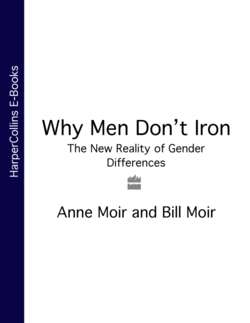Читать книгу Why Men Don’t Iron: The New Reality of Gender Differences - Anne Moir - Страница 8
CHAPTER TWO Foodsex I Perhaps he’s a rabbit
Оглавление‘What am I,’ asks Bill, ‘a f-f-fasting rabbit? All those raw leafies and tofuburgers. Even the meat – when it’s on the menu – is fatless and bloodless, shapeless and tasteless. No skin. Not a bone to chew …’
‘And I thought you were chewing on one,’ says Anne. ‘Where’re you heading?’
‘Out to buy some charcoal before the barbecue is banished. Food is going female.’
‘Perhaps it’s healthier?’
Two months later …
‘I did a MedLine search on male and female, food and mood,’ says Anne, ‘and what the whitecoat world finds is that this health food diet isn’t for him.’
‘What are you on about?’
‘What we were talking about. Whole food. Health food. I called up the research papers. Here are the first four boxes. Digest.’
A battle is being fought in the kitchen and the supermarket. The battle is about what we eat, and some of the heaviest guns are deployed by western governments which bombard us with health warnings, earnest advice and outright rules. Some of them ban unpasteurized dairy products, others refuse to let their citizens eat beef on the bone. If it were up to our governments, we would all live for ever. ‘You are,’ says the old adage, ‘what you eat’, and authority is determined that we should all munch our way into perpetual health.
Our mothers told us to eat up our greens, and that advice now haunts our adulthood. Not just our greens (preferably organic) must be eaten, but wholemeal breads, lentils, fruit and wholesome grains. Government mandates food labelling so we can be sure our diet is low-fat, low-calorie, low-sodium and high-fibre. It is not hard to detect a gender divide in these food wars. Broadly, he likes meat, she believes meat is bad and red meat is worse. Her diet is ‘healthier’, and no one seems to be pointing out how often that word dictates poverty of choice. But so what? Where once we chose our food for enjoyment and taste, now we are made to feel guilty if we do not regard our diet as a lifelong therapy. Eat up your greens, count your calories and beware of fat.
‘We do a lot of vegetables, and a lot of fibre and a lot of fruit,’ says Mrs Hillary Clinton. ‘That includes the President.’1
‘He always eat cheeseburgers,’ says Mrs Lucille Robinson (cook at Doe’s Eat Place, Little Rock, Arkansas) of Bill Clinton. ‘He’s just a burger lover.’2
President Clinton, like many other men, likes red meat, but Hillary Clinton, like many other women, shuns it. The drop in the consumption of red meat began in the late 1960s, and by the mid-80s it had dropped by half among well-educated, high-income American women. Even among low-income women it had dropped by a third.3 The same trend occurred in Britain where, by the health-conscious 90s, 43% of the population were eating less meat and most of those were women.4 A survey by the American government reveals that one woman in seven between the ages of 19 and 50 now avoids eating beef altogether.5 Given the chance, she will also make sure that her man does not eat red meat, and, institutionally at least, women do control men’s menus. The American Dietetic Association says that 97% of its 68,000 members are women, while women make up 98% of the British Dietetic Association.6 No fewer than thirty-two out of every thirty-three practising dieticians are female, so it is hardly suprising that the diet revolution is led by women. Red meat is out, wholegrains are in.
‘Where are these dieticians at?’ asks Anne.
‘A goat feeds and a man dines,’ says Bill. ‘And nutritionists cannot tell the difference.’
So what he likes (red meat) and what she provides (salad) are frequently different, and she usually wins the contest, for women, on the whole, have control of the family diet. It is also women who take a greater interest in the latest advice about nutrition in magazines and newspapers. Men are more sceptical, but a woman wants to keep her man healthy and see that he eats ‘well’. That means he must eat like her, and she justifies the change of his diet on the grounds of his health. Hard to argue with that, unless of course she has misunderstood what is going on. Has she?
It’s entirely possible she has, for there is little published material on the different food needs of the sexes. Texts on nutrition make little or no allowance for sexual dimorphism (dimorphism is the occurrence within a species of two distinct types of individual; ‘sexual dimorphism’ is the current jargon for male–female differences). In fact most of the male–female distinctions in food requirements have only recently become apparent, and very few of them are factored into current dietary recommendations. It is time, then, to distinguish what science has so skilfully detected. Time, perhaps, to rethink his menu, and the catalogue which follows is intended to provoke just such a reappraisal. It is a list of observed differences between the sexes, differences not only in how their bodies deal with ingested food, but why they might need different kinds of food in the first place.
First, though, we have to offer a health warning of our own. This chapter is not a discourse on dietetics or nutrition. It is an analysis of external social change set against what science has discovered about the inner nature of the sexes, especially the male, and the finding that the food he needs is not always the same as the food she needs. Sauce for the goose in not always suitable for the gander, because each has distinct metabolic mechanisms with different implications for diet, and the health police who increasingly hedge our foods with prohibitions do not yet understand the differences.
